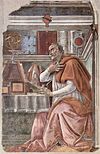Portal:Catholic Church
Introduction The Catholic Church, also known as the Roman Catholic Church, is the largest Christian church, with 1.39 billion baptized Catholics worldwide as of 2022. It is among the world's oldest and largest international institutions, and has played a prominent role in the history and development of Western civilization. The church consists of 24 sui iuris churches, including the Latin Church and 23 Eastern Catholic Churches, which comprise almost 3,500 dioceses and eparchies located around the world. The pope, who is the bishop of Rome, is the chief pastor of the church. The Diocese of Rome, known as the Holy See, is the central governing authority of the church. The administrative body of the Holy See, the Roman Curia, has its principal offices in Vatican City, a small independent city-state and enclave within the Italian capital city of Rome, of which the pope is head of state. The core beliefs of Catholicism are found in the Nicene Creed. The Catholic Church teaches that it is the one, holy, catholic and apostolic church founded by Jesus Christ in his Great Commission, that its bishops are the successors of Christ's apostles, and that the pope is the successor to Saint Peter, upon whom primacy was conferred by Jesus Christ. It maintains that it practises the original Christian faith taught by the apostles, preserving the faith infallibly through scripture and sacred tradition as authentically interpreted through the magisterium of the church. The Roman Rite and others of the Latin Church, the Eastern Catholic liturgies, and institutes such as mendicant orders, enclosed monastic orders and third orders reflect a variety of theological and spiritual emphases in the church. Of its seven sacraments, the Eucharist is the principal one, celebrated liturgically in the Mass. The church teaches that through consecration by a priest, the sacrificial bread and wine become the body and blood of Christ. The Virgin Mary is venerated as the Perpetual Virgin, Mother of God, and Queen of Heaven; she is honoured in dogmas and devotions. Catholic social teaching emphasizes voluntary support for the sick, the poor, and the afflicted through the corporal and spiritual works of mercy. The Catholic Church operates tens of thousands of Catholic schools, universities and colleges, hospitals, and orphanages around the world, and is the largest non-government provider of education and health care in the world. Among its other social services are numerous charitable and humanitarian organizations. (Full article...) Selected article
 Seton Hall University is a private Roman Catholic university in South Orange, New Jersey. Founded in 1856 by Archbishop James Roosevelt Bayley, Seton Hall is the oldest diocesan university in the United States.Seton Hall is also the oldest and largest Catholic university in the State of New Jersey. The university is known for its programs in business, law, education, nursing, and diplomacy, as well as its basketball team.Seton Hall is made up of nine different schools and colleges with an undergraduate enrollment of about 5,200 students and a graduate enrollment of about 4,500. Its School of Law, which is ranked as one of the top law schools in the nation,has an enrollment of about 1,200 students. The Seton Hall College of Medicine and Dentistry was acquired by the state in 1965, and is now the New Jersey Medical School, part of the University of Medicine and Dentistry of New Jersey.Like many Catholic universities in the US, Seton Hall arose out of the Plenary Council of American Bishops, held in Baltimore in 1844, with the goal of bringing Catholicism to higher education in order to help propagate the faith.
Selected image
 Credit: Stanislav Traykov
The Pietà (pl. same; Italian for pity) is a subject in Christian art depicting the Virgin Mary cradling the dead body of Jesus, most often found in sculpture. As such, it is a particular form of the devotional theme of Our Lady of Sorrows, and also a scene from the Passion of Christ. Selected biography
 Jesus of Nazareth (7–2 BC to 26–36 AD), also known as Jesus Christ, is the central figure of Christianity, revered by most Christians as the incarnation of God, and is also an important figure in several other religions. The name "Jesus" is an Anglicization of the Greek Ίησους (Iēsous), itself a Hellenization of the Hebrew יהושע (Yehoshua) or Hebrew-Aramaic ישוע (Yeshua), meaning "YHWH rescues". "Christ" is a title derived from the Greek Χριστός (Christós), meaning the "Anointed One," which corresponds to the Hebrew-derived "Messiah". The main sources of information regarding Jesus' life and teachings are the gospels. Most scholars in the fields of history and biblical studies agree that Jesus was a Galilean Jew, was regarded as a teacher and healer, was baptized by John the Baptist, and was crucified in Jerusalem on orders of Roman Governor Pontius Pilate, on the charge of sedition against the Roman Empire.
Did you know...
Related portalsFeast Day of May 27
Augustine was the prior of a monastery in Rome when Pope Gregory the Great chose him in 595 to lead a mission, usually known as the Gregorian mission, to Britain to Christianize King Æthelberht and his Kingdom of Kent from Anglo-Saxon paganism. Kent was likely chosen because Æthelberht commanded major influence over neighbouring Anglo-Saxon kingdoms in addition to his marriage to Bertha, a Frankish princess, who was expected to exert some influence over her husband. Before reaching Kent, the missionaries had considered turning back, but Gregory urged them on, and in 597, Augustine landed on the Isle of Thanet and proceeded to Æthelberht's main town of Canterbury. (Full article...)
Selected quote

News
SubcategoriesTopics
The Holy Bible:
Particular Churches (grouped by liturgical rite):
Things you can do
External resourcesWikiProjectsAssociated WikimediaThe following Wikimedia Foundation sister projects provide more on this subject:
Discover Wikipedia using portals |


































